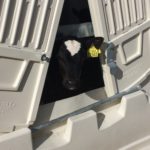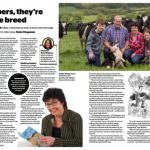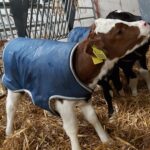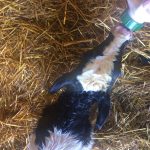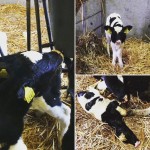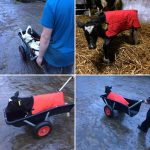
Calf Rearing
The calving season is progressing well and is keeping me busy. I started this post three weeks ago and am only getting back to it now.
The calving season started, as usual, with one cow calving a few days earlier than predicted but he wasn’t on his own for long. As the calving house filled up with more cows, it never ceases to surprise me how much cows will fight when re-introduced to each other. We had them housed in the 3 different areas according to calving date so there wouldn’t be too much mixing but even if they haven’t seen each other for a few days, they’ll still try to assert authority over each other. There was one heifer (only 2 years of age, a first time calver) who was going around headbutting everyone and trying to rule the roost. It’s unusual for a young cow to be so bolshy. Then Lucy, one of our older cows, went in to the calving house. Apart from the fact that we have huge respect for her (she’s a fine cow and mother of the first bull we sold to an AI company), she’s accustomed to being respected by other bovines. She took one look at the little whippersnapper and sorted her out in 30 seconds flat!
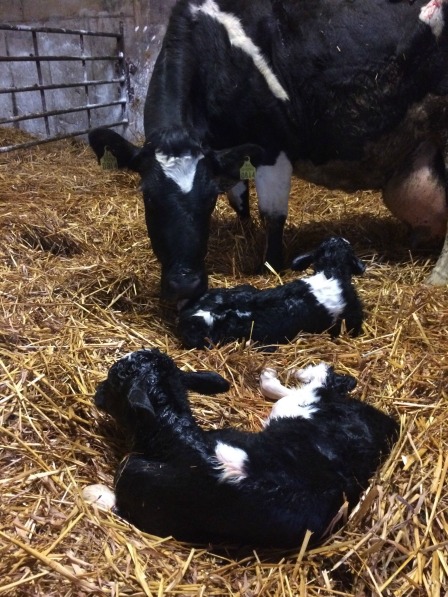 Our oldest cow, 14 years old now and on her 12th lactation, was expecting twins. We put her into the calving pen early to give her a few days peace on her own as she was getting to the stage she had enough of the company of others. Another cow would come in and calve and she never paid her or the newborn calf the least bit of attention. It seemed that we were waiting for ages but at last she gave birth to twin bull calves and all was fine. Brian milked her, I fed the calves and we left them together for the day. She was besotted with them and yet seemed happy to hand them over to their foster mother (me) at the end of the day!
Our oldest cow, 14 years old now and on her 12th lactation, was expecting twins. We put her into the calving pen early to give her a few days peace on her own as she was getting to the stage she had enough of the company of others. Another cow would come in and calve and she never paid her or the newborn calf the least bit of attention. It seemed that we were waiting for ages but at last she gave birth to twin bull calves and all was fine. Brian milked her, I fed the calves and we left them together for the day. She was besotted with them and yet seemed happy to hand them over to their foster mother (me) at the end of the day!
Over a hundred calves have been born now with about 25 left to calve within the next month. We had a couple of stillbirths but having delivered the bodies to the vet lab and no cause discovered, plus the fact that every other calf was hale and hearty, we just had to put them down to one of those unexplainable things. Touching wood here as I type but every calf born live has been looking for milk within half an hour of being born and many drank between 4-4.5 litres of colostrum, thereby giving them a good start regarding building their immunities. We’ve had problems with crypto in the past and although we’ve done everything possible to prevent it occurring again, it’s so infectious and hard to get rid of once it gets into a place, I’m on high alert watching out for it. Fingers crossed, it will stay at bay.
What do calves do all day? Well, they have a play after being fed and after receiving fresh bedding. The games they play look like tag, ring a ring a rosy and let’s race from one end of the pen to the other. Calves sleep a lot too so tend to have long afternoon naps as well as sleeping well at night. They also play at a kissing game after being fed when they try to suck the milk from each other’s noses so it looks like kissing!
We’ve been considering whether to build more calf housing or to use calf hutches so got a few hutches this year to try them. We put calf jackets on the newborn calves to give them some added protection and so far so good, they are all energetic and healthy, even though the weather two weeks ago really wasn’t pleasant. I would have felt very guilty putting them into the hutches and making them come out into the front gardens for food if they hadn’t had their coats.
The calf barrow is proving handy too. Thanks to a tip from Ken Foster, I always pull them into it back legs first now and it means they lie more quietly when being wheeled from calving pen to calf house or hutch.
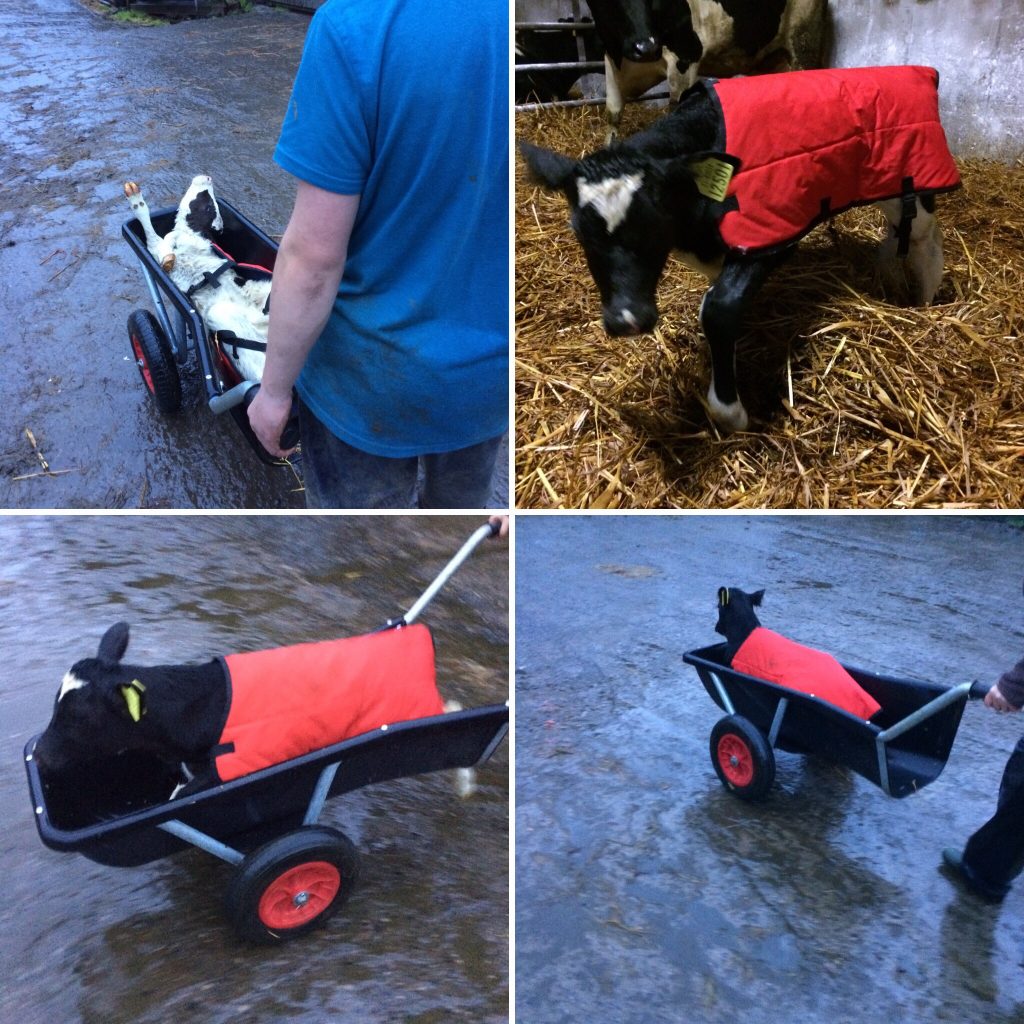
Going for a ride in a calf barrow in my new red coat
What was happening was the occasional one was turning around and while the one in this photo looks like she is enjoying the view, one or two were nearly walking out of the barrow by the time I got to the shed / hutch.
Calf Hutches
As I mentioned, we decided to experiment with two different types of calf hutches. One type were steel hutches large enough for ten calves, basic but requiring no work beyond putting them in place and securing gates to them. The others were plastic hutches to house six calves. They would require some installation work with gates that include a little “picket fence” style gate for me to open and walk through. “Wouldn’t that be handy?” I thought “No need to open wire on gates, pull a gate open or climb over gates when needing to sort calves out or train them to feed”. The steel hutches came first and Brian was impressed with how easy they were to put in place. “Maybe we should just order another two of them,” he said “and forget about the plastic ones”. But I was still hankering after my “picket fence” gates, after all, I’m not getting any younger and decided that for the sake of the experiment, we needed to get both types.
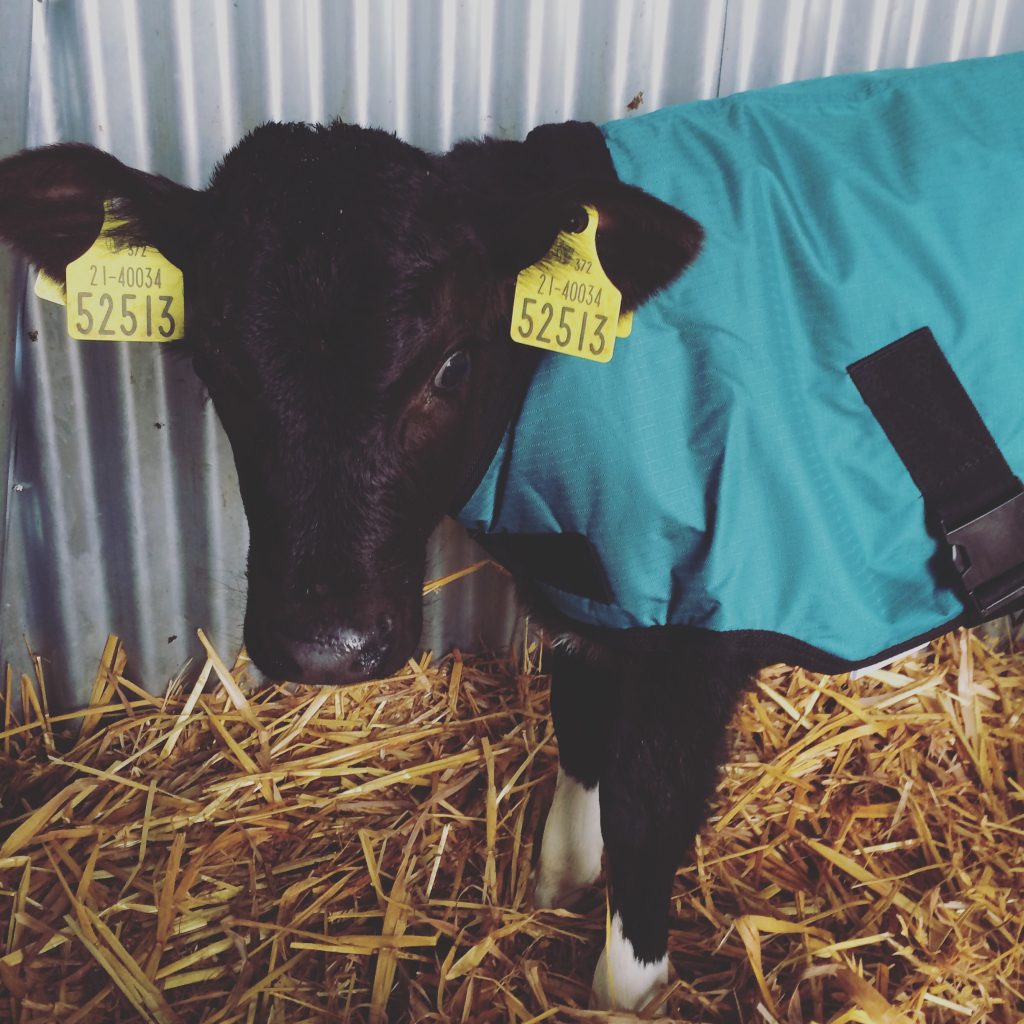
Susie sporting the green coat option from Mayo Healthcare
The plastic hutches arrived and as typically happens, many cows decided to calve a week early and suddenly both calf houses were full, the metal hutches were nearly full and we needed the plastic hutches as soon as possible so we started work on assembling the bag of tricks that came with them. Now the plastic shell had come in its entireity but various doors, windows and vents had to be joined to it and let’s just say, the instructions were either written by someone who didn’t have English as their first language or was trying to get the text to fit into one page so left out about half the words in each sentence.
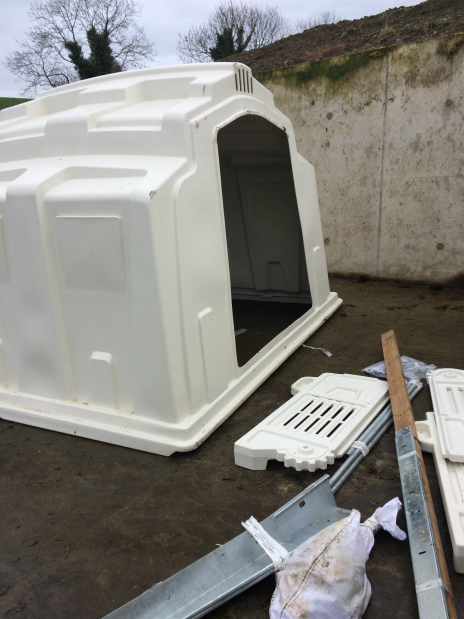
It didn’t take me long to get to the stage I was cursing buying them, not to mention knowing that if Brian had been the one to insist on ordering them, he’d have been sleeping in it. We got most of one finished before we had to start the evening jobs and I ended up housing six newborns in the corridor of the main calf house (don’t worry, it’s very wide and they had a comfy straw bed, it was just inconvenient for me really as I had to bottle feed them all again the next morning rather than trying to train them to drink from a feeder).
Thursday saw round 2 where we finished assembling the hutches and had to fix the gates to them. It was 2pm, Brian said he had to go at 3 to fodder cattle, rain was brewing and I had 12 calves in a steel hutch to move the 100 yards up a hill to these, and to put 6 from a calf shed into the steel hutch and be in Kilkenny for 5:30 to collect the kids.
I looked for the instructions and there weren’t any. Now, I am the world’s worst for reading instructions but it’s a different story when there aren’t any. I just wanted something like the instructions that Lego provides – a picture and a bit of text. Our stumbling block was trying to work out how to join the gates to the sides of the slanting plastic edges of the hutch. Brian had lost the number of the rep but called the company and left a message. No call back. Our conversation went like this:
Brian “Is this the way it goes?”
Me: “How am I meant to know? I’m not an engineer”
Brian “No, it isn’t. It can’t be that difficult surely. Um”
Stands and looks at it for 5 minutes trying to turn the things different ways. He checks their website which is “under construction” and then their online catalogue but the photos of how to join the gates to the corners weren’t clear.
Brian: “We’ve got five degrees between us, we should be able to work it out, this is ridiculous”
Me: “But neither of us are engineers. Did you play with Meccano as a kid?”
Brian “No, not really”
Me “We’re fecked then, me neither.”
Brian worked it out eventually, if it had been up to me, I’d have sent the whole lot back. Okay, it was kind of obvious when you knew how to do it but a complete mystery when you didn’t.
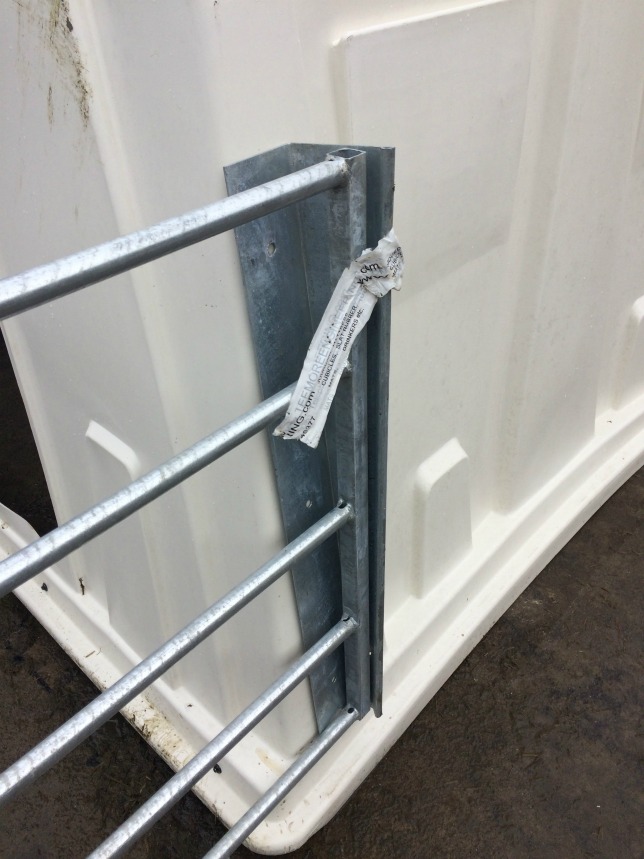
Well, it’s still not obvious to me, but maybe to some people but I couldn’t believe that a company that makes gates has to devise such a complicated system and doesn’t have the cop on to create some simple instructions with a few photos. All they have to do is look at how the big guys like Ikea and Lego do it and follow their example.
There were lots of bits left over too. I’m sure it’s not the right use for it but I used two of the left over poles to prop the windows open part-way! Not advocating violence here but there were plenty of places I felt like shoving the pole if I could have got my hands on anyone in the company!
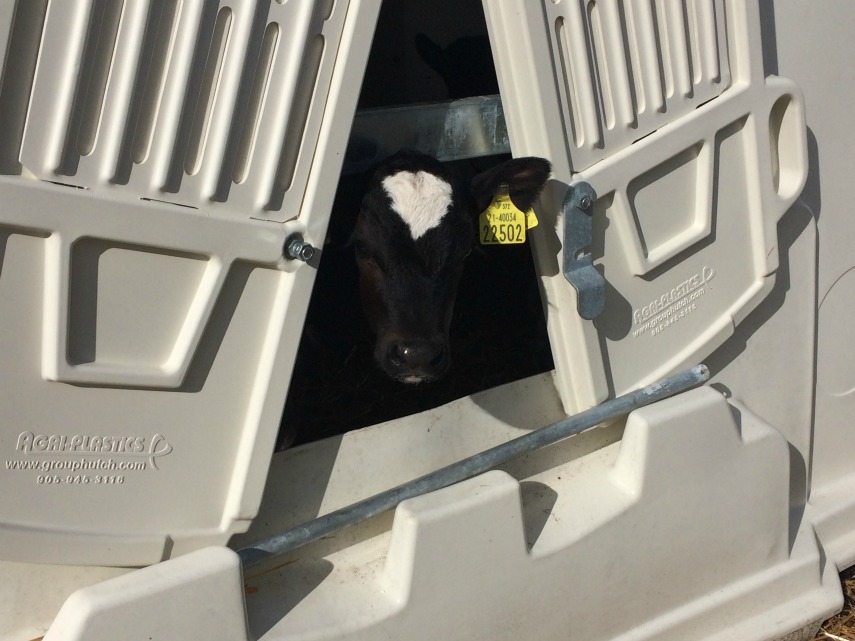
Anyway, I got my dad to help me move the 18 calves (that calf barrow came in handy again) and my mum to collect the kids and I collapsed into a heap that evening! I left a comment on the company’s facebook page the following Monday. They responded via message from one of the employee’s personal facebook accounts (which is a huge no no), and said they’d get someone to call. A week later, I received a phone number. When I phoned the guy, he admitted that no written instructions were available – which is what the facebook person could have told me in the first place.
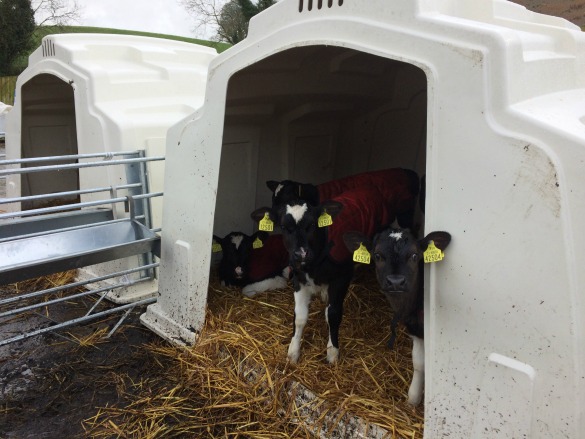
I’ll be doing a full review of the hutch system at the end of the calving season (we’re trying out calf jackets and peat bedding too – this isn’t a sponsored post by the way, all items have been paid for in full) so I’ll let you know what ones work out best in our humble opinions. I’ll tell you about our milk powder saga in another post! I feel I could write a book on things those in customer service should not do!
Our herd was featured in an article on Agriland by the way – it’s mostly about the herd genetics and our breeding strategy in our goals to attain improved milk solids.
Writing & Press Coverage
To be honest, apart from not having the time or energy to write blog posts, I haven’t been doing much writing of books lately either but hopefully things on the farm will quieten down now and I’ll have more time. I did deliver my first ever after-dinner speech though! It wasn’t on my to-do list for the year but when asked to do one, I thought “why not?” Isn’t it strange how we tend to be quite relaxed about things which are way into the future but it’s a different story when the event gets closer and you’re worrying if you’re going to sound stupid. To make matters worse, I knew that quite a few people in the audience would be known to me and that’s always worse than talking in front of strangers (in my opinion) but I survived it anyway and can tick that one off the non-existant to-do list!
I may not have been writing but I’ve got some great press coverage in the UK. First up was a three page spread in the February edition of NFU Countryside magazine.

Then, I was featured in a double page spread in Farmers Guardian – and it’s available to read online too.
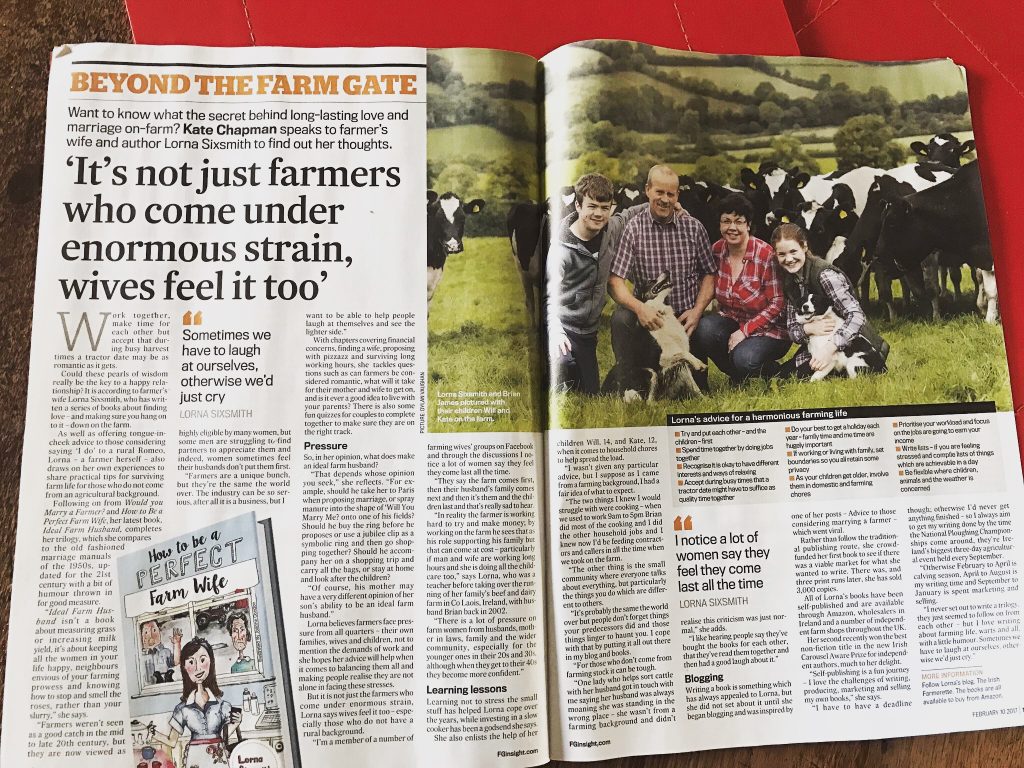
And last but not least, Writers Forum did a piece on me, my crowdfunding, and my self publishing journey. Huge thanks to Kate Chapman for writing all of these pieces.
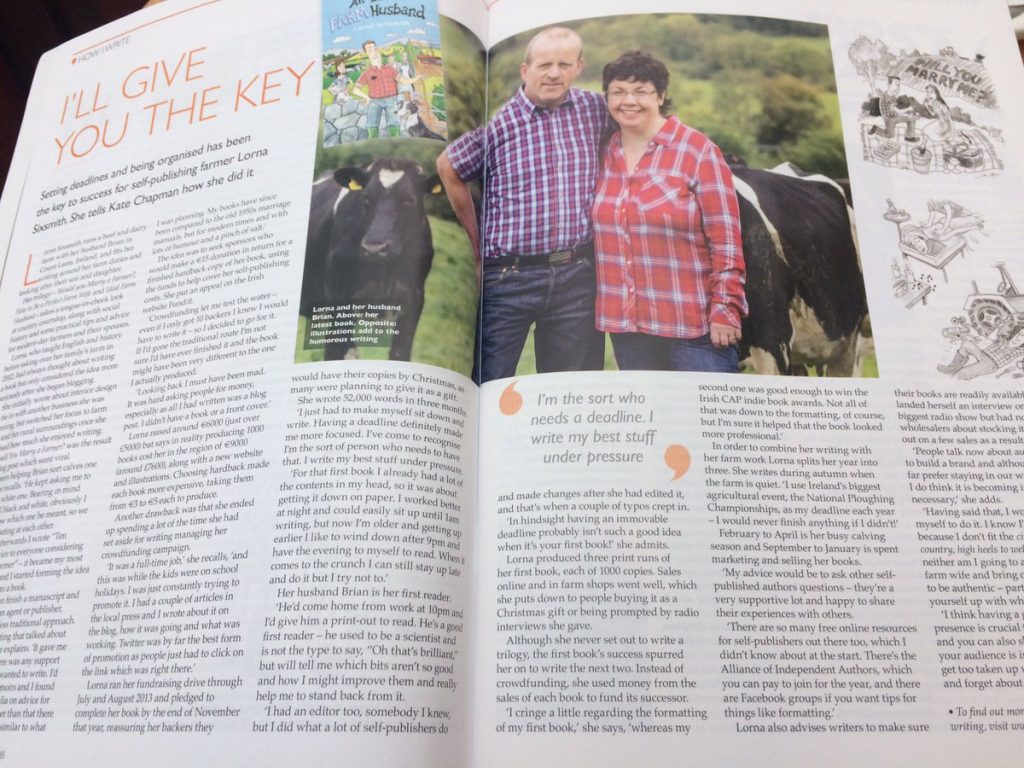
I’m attending (and being a panelist) at the CAP Awards this Saturday so am looking forward to a day in the big smoke!
Social Media for Writers
Farmland Magazine UK are running a competition for a copy of How to be a Perfect Farm Wife over on Twitter, all you have to do for a chance to win is follow them and retweet this tweet.
I think that is all of my news. I’ll leave you with these lovely tweets I received about my book and remember, if you’re looking for a gift for your farming mum, you know what book to buy her. It’s never to late to try to be a perfect farm wife!
One of the beauties of social media for a writer is when you receive a tweet telling you they loved your book or sharing a photo of your book being read or in an impressive location.
I was delighted to get not just one but two compliments with these “quote tweets”.
A fantastic and witty read for farm husbands too @IrishFarmerette https://t.co/H4N5ufqzrM
— Will Evans (@willpenrievans) March 15, 2017
Farm wife or not, this is a fantastic and witty read. https://t.co/u5ttFMqFtF
— Modern Wife Exhibit (@ModWifeExhibit) March 14, 2017
I was amused to read that An Ideal Farm Husband is the “new bible” in this house.
It's the new bible in our house. He's learning b4 we tie the knot ???????????? @IrishFarmerette pic.twitter.com/J2uxMXBHKW
— Mimi (@EmeeMimi) February 18, 2017






